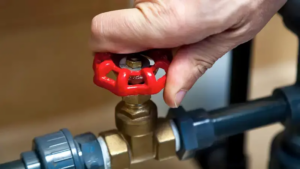A plumbing emergency, such as a burst pipe, overflowing toilet, or major leak, can cause serious water damage if not handled quickly. Knowing how to shut off your water supply can prevent flooding, protect your home, and save you from costly repairs.
At Plomberie Viau, we specialize in emergency plumbing services and can help you stop leaks, repair burst pipes, and restore your plumbing system. In this guide, we’ll show you how to locate and shut off your water supply in different emergency situations.

Why Is It Important to Shut Off Your Water?
Water can spread rapidly, causing damage to floors, walls, furniture, and electrical systems. In some cases, mold growth and structural issues can occur if water isn’t stopped in time.
By knowing how to quickly turn off your water, you can:
✔️ Prevent extensive water damage
✔️ Avoid high water bills from wasted water
✔️ Keep your plumbing system safe until a professional plumber arrives
🚨 In any major plumbing emergency, shutting off the water should be your first step before calling a plumber!
Step-by-Step Guide: How to Shut Off Water in an Emergency
The method you use to turn off your water depends on where the leak or issue is happening.
1. Shutting Off the Main Water Supply (For Major Emergencies)
If you have a burst pipe, major leak, or multiple fixtures overflowing, you’ll need to shut off the main water supply to your entire home.
🔧 How to Find & Turn Off the Main Water Shut-Off Valve:
✔️ The main shut-off valve is usually located where the main water line enters your home (often near the basement, garage, laundry room, or an exterior wall).
✔️ Turn the valve clockwise (right) to close it.
✔️ If you have a lever-style valve, turn it 90 degrees (perpendicular to the pipe) to shut off the water.
🚨 Tip: Every homeowner should locate their main water shut-off valve before an emergency happens. If you’re unsure where it is, contact Plomberie Viau for a professional plumbing inspection.
2. Shutting Off Water to a Specific Fixture (For Minor Leaks & Repairs)
If the problem is coming from a single sink, toilet, or appliance, you can shut off the water only to that fixture instead of turning off the whole house’s supply.
💧 How to Shut Off Water to Common Fixtures:
🚰 Sinks & Faucets
✔️ Look under the sink for two shut-off valves (one for hot water, one for cold water).
✔️ Turn the valve clockwise to shut off the water.
🚽 Toilets
✔️ Locate the small shut-off valve behind or beneath the toilet.
✔️ Turn it clockwise to stop water flow to the toilet tank.
🚿 Showers & Bathtubs
✔️ Some showers have a shut-off valve behind an access panel (often located behind the bathroom wall or inside a closet).
✔️ If you can’t find it, shut off the main water supply.
🧺 Washing Machines & Dishwashers
✔️ Washing machines usually have two valves (hot & cold) behind them. Turn both clockwise to shut off water.
✔️ Dishwashers may have a shut-off valve under the kitchen sink connected to the hot water supply.
3. Turning Off Your Water Heater (To Prevent Damage)
If you have a leak coming from your water heater, it’s important to shut off the water and power to prevent flooding or overheating.
🔥 How to Shut Off a Water Heater Safely:
✔️ Turn off the cold water supply valve (located on top of the heater).
✔️ If you have a gas water heater, turn the gas valve to the “off” position.
✔️ For electric water heaters, switch off the circuit breaker connected to the heater.
🚨 Warning: Never drain a hot water heater without turning off the power first—this can damage the unit!
What to Do After Shutting Off the Water
Once you’ve turned off the water, follow these steps to minimize damage and prepare for repairs:
✔️ Drain the remaining water → Open faucets and flush toilets to release pressure.
✔️ Soak up standing water → Use towels, mops, or a wet vacuum.
✔️ Inspect for damage → Check for wet walls, ceilings, and floors.
✔️ Call a professional plumber → Contact Plomberie Viau for emergency repairs and leak detection.
🚨 If you see severe flooding, mold, or structural damage, call a plumber immediately!
How to Prevent Future Plumbing Emergencies
The best way to avoid costly plumbing disasters is to practice regular maintenance and make sure your plumbing system is in good condition.
✅ 1. Inspect Your Plumbing System Regularly
- Check for leaky pipes, dripping faucets, and loose connections.
- Test shut-off valves twice a year to ensure they work properly.
✅ 2. Insulate Pipes to Prevent Freezing
- Wrap exposed pipes with foam insulation during winter.
- Let faucets drip in extremely cold weather to prevent frozen pipes.
✅ 3. Monitor Your Water Pressure
- High water pressure can stress pipes and lead to leaks.
- Install a water pressure regulator to maintain safe pressure levels (40-60 psi).
✅ 4. Know Where Your Shut-Off Valves Are
- Every household member should know how to turn off the water in an emergency.
- Label shut-off valves for quick identification.
✅ 5. Schedule Professional Plumbing Maintenance
- Plomberie Viau offers preventative plumbing inspections to detect and fix issues before they turn into emergencies.
Final Thoughts
Knowing how to quickly shut off your water supply can prevent extensive damage during a plumbing emergency. Whether dealing with a burst pipe, overflowing toilet, or appliance leak, acting fast can save your home from costly repairs.
If you need emergency plumbing assistance, don’t wait—contact Plombier Beloeil for fast, professional plumbing services!